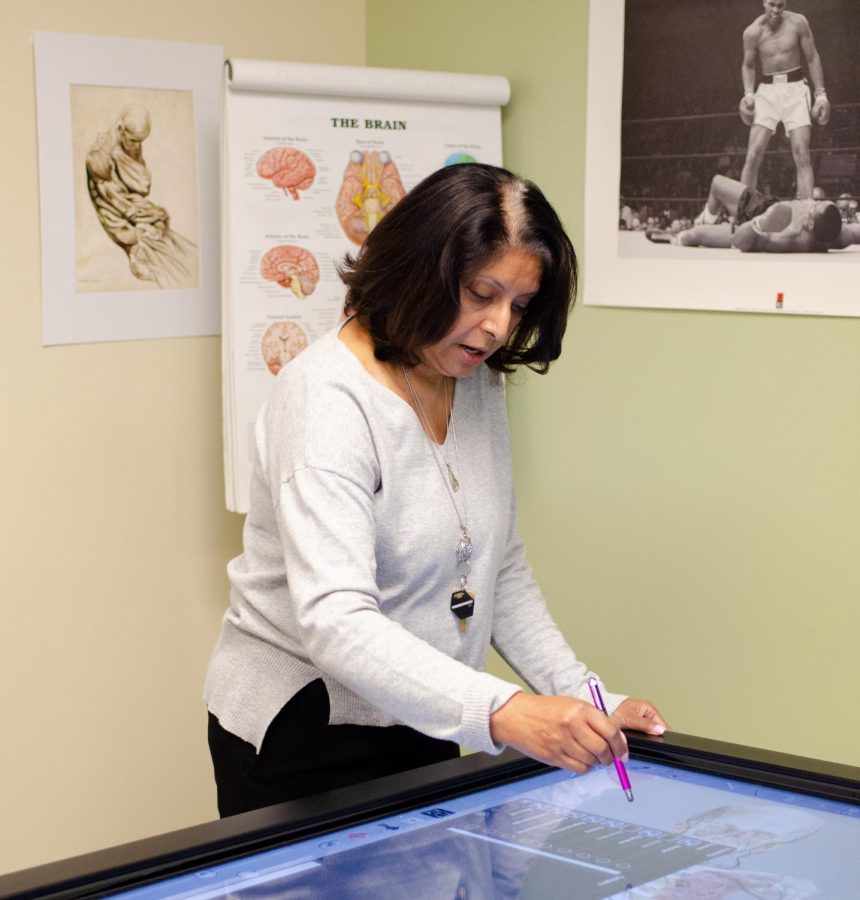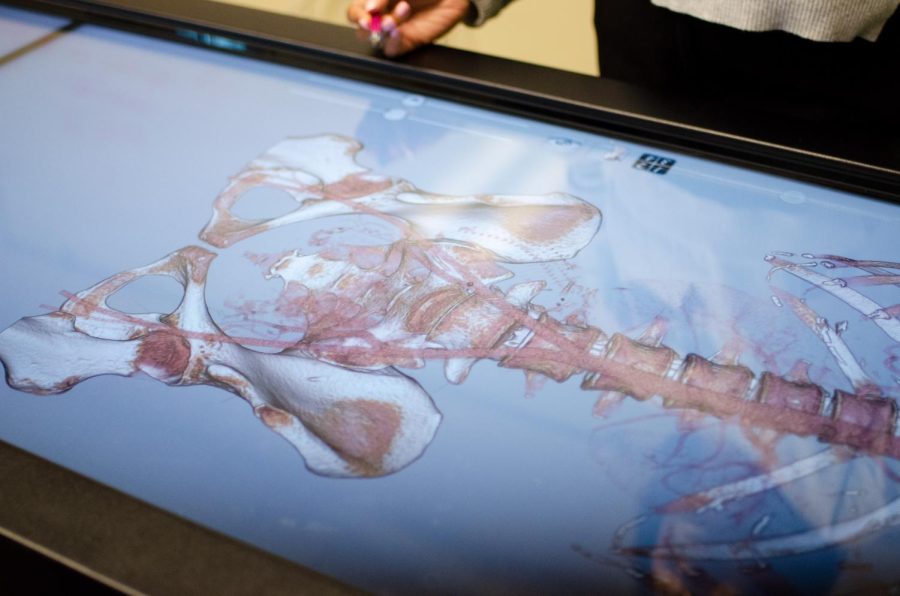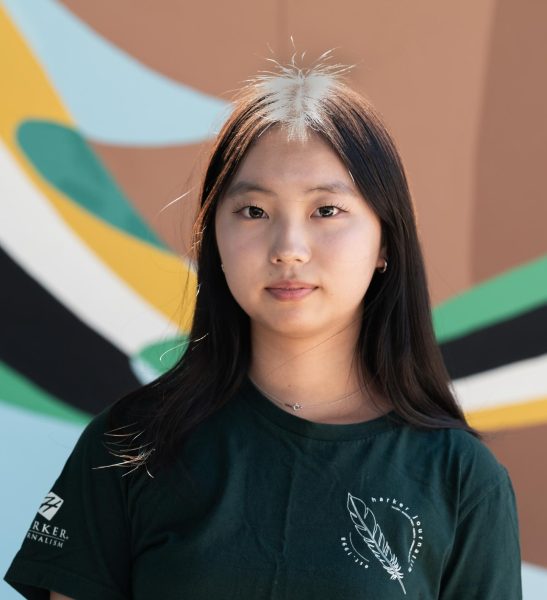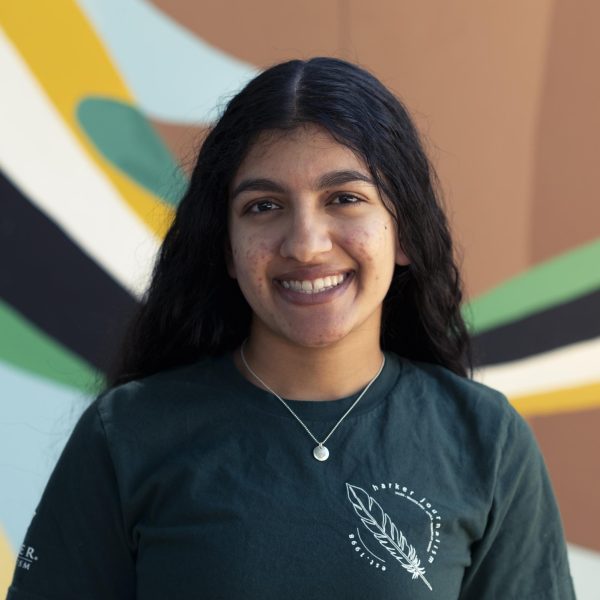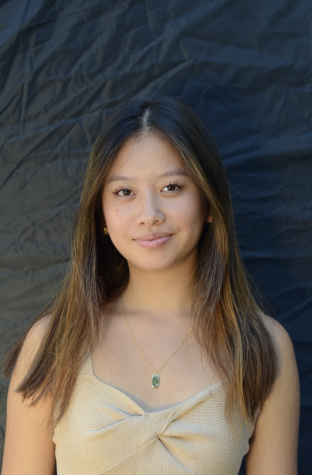Anatomage table facilitates interactive learning and study of the human body
Using a stylus, upper school science department chair and biology teacher Anita Chetty selects certain features on the body to be visible. The table also allows the user to place labels on body organisms, view the flow of blood in the veins, and take a quiz on the anatomy of the cadaver.
June 4, 2022
An image of a dissected human body with red, flowing blood vessels and ivory-colored bones is displayed on a large table, about six feet long and two feet wide. Upper school science department chair and biology teacher Anita Chetty uses a cushioned stylus to manipulate the body, rotating it and pointing at various bones and organs. Then, with just a click of a button, the entire screen switches to a separate dissected layer in the body.
The upper school, with the help of multiple parent donations, purchased the $60,000 Anatomage virtual cadaver dissection table in 2014, and Chetty has been using it to aid in her instruction of the Human Anatomy and Physiology classes ever since. With the table, students can study the internal and external anatomies of four human bodies and can perform various cuts, dissections and rotations.
“I think students really enjoy the interactive nature [of the Anatomage table],” Chetty said. “I think that this generation learns very well through visual cues, through digital formats. So a tool like [the table] really is aligned with the way they receive and process and communicate information.”
The table’s four pre-loaded human cadavers include a young female with cancer; a young male with cancer; a male with a brain tumor, who was executed by lethal injection and an older female. In order for their bodies to be used in Anatomage tables, each cadaver was scanned with X-ray, magnetic resonance imaging (MRI) and computed tomography (CT) technology. Afterwards, they were frozen and sliced into transverse sections with the thickness of a dime. Finally, each section was photographed, and all images and scans were loaded onto the table.
In addition to the four cadavers, the table contains other medical case studies, including patients with stab wounds, gunshot injuries, aneurysms and ectopic pregnancies, where the fetus does not lie in the uterus.
“The [case study] that I enjoyed the most was an ectopic pregnancy,” past Human Anatomy and Physiology student Spencer Cha (’22) said. “It’s just cool to see and realize that ‘Oh, there’s a spine that’s not in the uterus and very much out of the abdominal cavity.’”
The Human Anatomy and Physiology course, only offered to seniors, allows students to pursue a deeper learning and more interactive exploration of the human body and health. Due to its quiz, annotation and split-screen features, Chetty has found that the table is a helpful teaching tool for the class, and throughout the school year, Chetty brings her classes to the table’s room.
Community members outside of the Human Anatomy and Physiology class have also interacted with the table. At the annual Research Symposium, organized by Women in STEM (WiSTEM) club members, the students give live demonstrations of the table to attendees. The STEM Buddies program, directed towards young students in elementary and middle school, hopes the table sparks more interest in medicine.
“We really liked the idea of the kids getting to see a much more comprehensive and in-depth view of the human body,” WiSTEM officer and STEM Buddies Coordinator Eileen Ma (11) said. “It’s just a really good experience for the little kids to get excited about high school and all the opportunities it has to offer.”
Spencer, one of the students who demonstrated the table at Symposium this year, notes that attendees were “quite impressed” by the tool’s features and capabilities.
“A lot of [the attendees] were asking us interesting questions,” Spencer said. “They were like, ‘Oh, what about here? What if you did this?’ I think the curiosities of the kids, in all the audiences, made it quite interactive.”
In recent years, the school has shown significant support for science and research programs, according to Chetty.
“We’re very fortunate to have an administration that is so supportive of novel ideas,” Chetty said. “I feel as though one of the reasons why we seem to progress as a school is because new ideas and unique ideas for exploration are encouraged and supported.”


















![“[Building nerf blasters] became this outlet of creativity for me that hasn't been matched by anything else. The process [of] making a build complete to your desire is such a painstakingly difficult process, but I've had to learn from [the skills needed from] soldering to proper painting. There's so many different options for everything, if you think about it, it exists. The best part is [that] if it doesn't exist, you can build it yourself," Ishaan Parate said.](https://harkeraquila.com/wp-content/uploads/2022/08/DSC_8149-900x604.jpg)




![“When I came into high school, I was ready to be a follower. But DECA was a game changer for me. It helped me overcome my fear of public speaking, and it's played such a major role in who I've become today. To be able to successfully lead a chapter of 150 students, an officer team and be one of the upperclassmen I once really admired is something I'm [really] proud of,” Anvitha Tummala ('21) said.](https://harkeraquila.com/wp-content/uploads/2021/07/Screen-Shot-2021-07-25-at-9.50.05-AM-900x594.png)







![“I think getting up in the morning and having a sense of purpose [is exciting]. I think without a certain amount of drive, life is kind of obsolete and mundane, and I think having that every single day is what makes each day unique and kind of makes life exciting,” Neymika Jain (12) said.](https://harkeraquila.com/wp-content/uploads/2017/06/Screen-Shot-2017-06-03-at-4.54.16-PM.png)








![“My slogan is ‘slow feet, don’t eat, and I’m hungry.’ You need to run fast to get where you are–you aren't going to get those championships if you aren't fast,” Angel Cervantes (12) said. “I want to do well in school on my tests and in track and win championships for my team. I live by that, [and] I can do that anywhere: in the classroom or on the field.”](https://harkeraquila.com/wp-content/uploads/2018/06/DSC5146-900x601.jpg)
![“[Volleyball has] taught me how to fall correctly, and another thing it taught is that you don’t have to be the best at something to be good at it. If you just hit the ball in a smart way, then it still scores points and you’re good at it. You could be a background player and still make a much bigger impact on the team than you would think,” Anya Gert (’20) said.](https://harkeraquila.com/wp-content/uploads/2020/06/AnnaGert_JinTuan_HoHPhotoEdited-600x900.jpeg)

![“I'm not nearly there yet, but [my confidence has] definitely been getting better since I was pretty shy and timid coming into Harker my freshman year. I know that there's a lot of people that are really confident in what they do, and I really admire them. Everyone's so driven and that has really pushed me to kind of try to find my own place in high school and be more confident,” Alyssa Huang (’20) said.](https://harkeraquila.com/wp-content/uploads/2020/06/AlyssaHuang_EmilyChen_HoHPhoto-900x749.jpeg)



